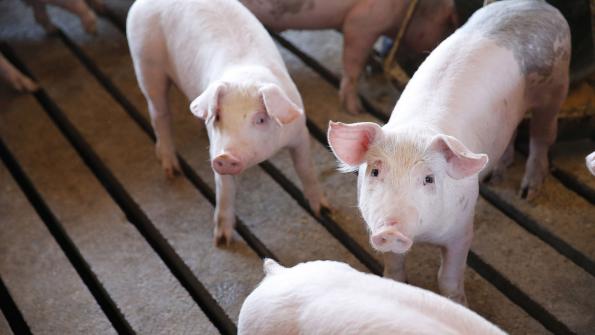However you evaluate opportunities, the goal should be to strive to maintain a strong balance sheet with liquidity, improve production, reduce costs and maximize the value of the pigs sold.
November 21, 2016

Hog prices continue to remain very soft with large numbers of pigs available for slaughter. Futures for December lean hogs moved up from a low of less than $42 to near $48 in mid-November.
There is at least some hope, that with recent moves in higher nearby futures, prices won’t fall further. The past few months have been very difficult for production margins, erasing all of the profits earned in the first three quarters of the year.
Producers are frustrated due to the fact that product values (cutout) are virtually the same as a year ago at this time, but live hogs are bringing $20 per head less. The outlook has improved, but does indicate negative margins for the next six months somewhere near $20 per head.
[CHARTBEAT:3]
Market drivers
The biggest driver of weaker markets this fall has, clearly, been due to the larger-than-expected slaughter numbers. Pigs harvested weekly since early September have been 6% to 9% higher this year compared to last, at least in the weeks we haven’t had issues with plants in the southeast.
This was unexpected based on the Sept. 1 USDA Hogs and Pigs report, which indicated pigs in inventory over 120 pounds at that time were 104% of last year. Saturday slaughter numbers have been high, increasing labor costs for packers, but the biggest issue, in my opinion, is reaching packer capacity and the ability of packers bidding hogs to fill their capacity.
Cutout values have remained strong given the amount of pork available. With the rapid increase in slaughter numbers and seasonal carcass weight gains, the United States has clearly increased production a great deal. Although recent export numbers are not yet available, I would assume that there is some modest growth based on what I have been hearing.
All this points to very strong domestic demand for pork products in a time when there is more beef and more chicken available as well. That is good news for our industry as we are gaining some market share and moving the needle on pork demand.
Outlook
We find ourselves looking forward to some new realities in the industry. We will likely have the largest increase in slaughter capacity in history over the next 12 months. This should help the live market relative to the cutout as packers bid for more pigs to fill capacity.
A more typical live hog demand with current cutout values would probably yield $62 to $64 lean hogs, likely near breakeven, at least for low-cost operations.
We know there has been expansion in the industry in terms of new sows. This will provide more pigs for packers to purchase next year when capacity is larger, but what is also clear is that we will have more pork to move. Strong domestic demand and growth in exports will be critical to this industry’s success in the future.
Year-end planning
For many, this time of year is when you put together strategies for the coming year, which usually include budgets, forecasts and capital plans. Working capital is always most important, and maintaining working capital in your business should be your first priority. That might require forgoing some capital plans for a time, restructuring some current debt, or other strategies that preserve or build working capital.
Every operation will have their own way of prioritizing and executing these planning strategies. However you evaluate opportunities, the goal should be to strive to maintain a strong balance sheet with liquidity, improve production, reduce costs and maximize the value of the pigs sold.
Cost of production comparison to the Iowa State University Estimated Returns model is a good place to evaluate where you need to spend time working on costs. The cost of production from January through October 2016 on that model indicates cost of production of $63.72 per hundredweight (carcass) and revenue of $63.75 in the same time period. Our analysis of those costs at AgStar lead us to believe that cost of production would put you in the top 25% of U.S. producers.
Bang has more than 30 of experience in the swine industry and serves as the swine team leader for AgStar Financial Services. For more insights from Bang and the AgStar Swine Team, including their weekly video Hog Blog, visit AgStaredge.com.
You May Also Like


